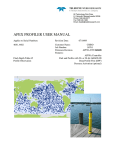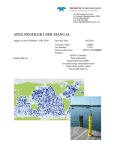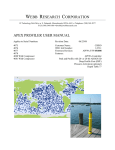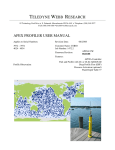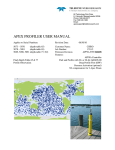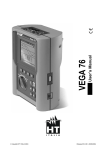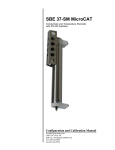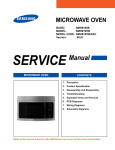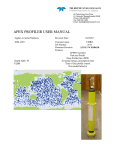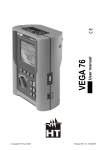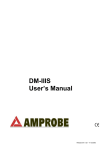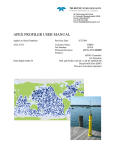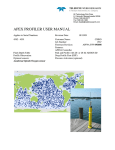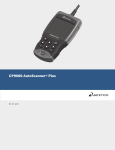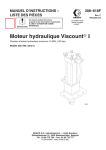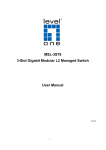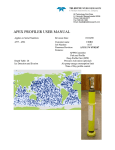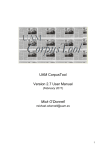Download 042508 - CSIRO Marine and Atmospheric Research
Transcript
WEBB RESEARCH CORPORATION 82 Technology Park Drive • E. Falmouth, Massachusetts 02536-4441 • Telephone (508) 548-2077 FAX (508) 540-1686 • [email protected] APEX PROFILER USER MANUAL Applies to Serial Numbers:3975~3974 Revision Date: Customer Name: CSIRO WRC Job Number: 1506 Firmware Revision Features: 04/25/08 APF9A F/W 013108 APF9A Controller Park and Profile with 20- or 28-bit ARGOS ID Deep Profile First (DPF) Pressure Activation (optional) I. Alkaline Battery Warning ________________________________________________ 3 II. APF9 Operations Warning for APF8 Operators ____________________________ 4 III. Maximum Operating Pressure __________________________________________ 5 IV. Evaluating the Float and Starting the Mission _____________________________ 6 A. Manual Deployment with the Reset Tool_________________________________________ 7 B. Pressure Activation Deployment _______________________________________________ 8 C. Mission Activation and Mission Prelude ARGOS Transmissions_____________________ 9 D. Mission Activation and Operator Float Function Check ___________________________ 10 E. Notes and Caveats __________________________________________________________ 13 V. Deploying the Float _____________________________________________________ 14 VI. Park and Profile _____________________________________________________ 15 A. Profile Ascent Timing _______________________________________________________ 15 B. Profile and Profile Cycle Schematics ___________________________________________ 16 VII. Deep Profile First (DPF)_______________________________________________ 17 VIII. ARGOS Data ______________________________________________________ 18 A. SERVICE ARGOS Parameters _______________________________________________ 18 B. Test Messages - 28-bit ARGOS ID - Mission Prelude _____________________________ 19 C. Data Messages - 28-bit ARGOS ID_____________________________________________ 22 D. Conversion from Hexadecimal to Physical Units _________________________________ 27 E. Depth Table 26 for PTS Samples ______________________________________________ 28 F. Telemetry Error Checking (CRC) _____________________________________________ 29 IX. Missions ____________________________________________________________ 30 Appendix A: Surface Arrival Time and Total Surface Time ______________________ 35 Appendix B: Argos ID formats, 28-bit and 20-bit ________________________________ 36 Appendix C: Storage conditions ______________________________________________ 36 Appendix D: Connecting a Terminal __________________________________________ 37 Appendix E: APF9A Command Summary _____________________________________ 38 Appendix F: Returning APEX floats for factory repair or refurbishment____________ 41 Appendix G: CTD Calibration and Ballasting records ___________________________ 42 2 of 42 I. Alkaline Battery Warning The profiler contains batteries comprised of alkaline manganese dioxide "D" cells. There is a small but finite possibility that batteries of alkaline cells will release a combustible gas mixture. This gas release generally is not evident when batteries are exposed to the atmosphere, as the gases are dispersed and diluted to a safe level. When the batteries are confined in a sealed instrument mechanism, the gases can accumulate and an explosion is possible. Webb Research Corp. has added a catalyst inside of these instruments to recombine hydrogen and oxygen into H2O, and the instrument has been designed to relieve excessive internal pressure buildup by having the upper end cap release. Webb Research Corp. knows of no way to completely eliminate this hazard. The user is warned, and must accept and deal with this risk in order to use this instrument safely as so provided. Personnel with knowledge and training to deal with this risk should seal or operate the instrument. Webb Research Corp. disclaims liability for any consequences of combustion or explosion. 3 of 42 II. APF9 Operations Warning for APF8 Operators This APEX manual describes floats using a new controller design. The new design is designated APF9. The prior design, which is still in production and widely used, is designated APF8. The operator interface and behavior of the APF9 are similar to, but not identical to, the operator interface and behavior of the APF8. If you are an experienced APF8 user, please observe appropriate cautions and do not assume an expected behavior. Several important differences are listed below. These points should also be helpful to those without an APF8 background. • To reset an APF9 for a deployment you should hold the Reset Tool stationary against the RESET label until you hear the air pump run. Typically, the air pump will run 2 to 3 seconds after you position the Reset Tool over the RESET label. (For the APF8 it was necessary to hold the Reset Tool in place and then remove it to trigger the float.) • The serial baud rate for communications is 9600, with 8 data bits, no parity, and 1 stop bit. (The APF8 baud rate is 1200.) • If not already in Command Mode, an APF9 can only enter Command Mode from Sleep. Either the Reset Tool or a keystroke at the terminal will trigger the transition from Sleep to Command Mode. • If the APF9 is performing some task (e.g., self tests), it is not listening and cannot be placed in Command Mode with either the Reset Tool or a keystroke at the terminal. o There is one exception. If the piston is moving, the Reset Tool (but not a keystroke) can be used to terminate the move. The APF9 will transition to its next state or task. Typically this will be either Command Mode or Sleep, so try a keystroke or a second application of the Reset Tool after the piston stops to confirm or trigger the transition to Command Mode. • If the APF9 is not responding, it is probably busy with some task. Be patient and occasionally try to get the attention of the float with either the Reset Tool or a keystroke. 4 of 42 III. Maximum Operating Pressure APEX profilers have a maximum operating pressure of 2000 dbar (2900 psi). However, for shallower applications, thinner walled pressure cylinders can be used. These cylinders have a reduced pressure rating, but less mass, which allows them to carry a larger battery payload. Three cylinder pressure ratings are available: • 2000 dbar • 1500 dbar • 1200 dbar maximum pressure rating battery payload typically 14% greater than with 2000 dbar cylinder battery payload typically 28% greater than with 2000 dbar cylinder For example, if an APEX profiler is specified by the customer for 1400 dbar maximum (profile) depth, then the 1500 dbar cylinder would normally be used. CAUTION: If you will be: • Exposing floats to significant hydrostatic pressure during ballasting or testing • Re-ballasting and re-programming floats for a depth greater than the original specification Please contact Webb Research to confirm the pressure rating of specific floats. Do not exceed the rated pressure, or the hull may collapse. 5 of 42 IV. Evaluating the Float and Starting the Mission Profilers are shipped to the customer in Hibernate mode. The Pressure Activation feature is NOT ACTIVE. With the Pressure Activation feature included in this version of the APF9A firmware, there are two possible deployment procedures. The procedures are described below. IMPORTANT: Pressure Activation is NOT automatic for this firmware version of the APF9A. The Pressure Activation feature MUST be MANUALLY ACTIVATED by the OPERATOR using a PC to communicate with the float. The following sections, "Manual Deployment with the Reset Tool" and "Pressure Activation Deployment", provide operational summaries for these two possible deployment scenarios. Both sections refer to self tests conducted by the float and float function checks performed by the operator. A detailed description of proper float behavior, self tests, and the associated operator actions and observations needed to evaluate the float for deployment is provided in "Mission Activation and Operator Float Function Check". IMPORTANT: The float should not be deployed if it does not behave as described in "Mission Activation and Operator Float Function Check". Webb Research Corporation strongly recommends testing all APEX Profilers on receipt by the customer and before deployment to ensure no damage has occurred during shipping. 6 of 42 A. Manual Deployment with the Reset Tool Shortly before deployment, reset the profiler by holding the Reset Tool over the marked location on the pressure case. Hold the Reset Tool in position for approximately 3 seconds. Remove the Reset Tool only after you hear the air pump activate. The float will run a brief self test. This is the Mission Activation phase. During this time the operator should verify proper function of the float (see "Mission Activation and Operator Float Function Check"). The float will then transmit test messages for 6 hours at the programmed repetition rate during the Mission Prelude phase. Six hours is typical; the duration of the Mission Prelude can be set by the operator. The piston will be fully extended at the beginning of the Mission Prelude (before the test transmissions begin) and the air bladder will be fully inflated during the first dozen or so test transmissions. At the conclusion of the Mission Prelude the float will begin its pre-programmed mission. Manual Deployment Summary: • Hold the Reset Tool over the RESET label • Mission Activation o Air pump runs once o Self test conducted (see below for verification procedure) § Internal tests run (can be monitored if communication cable is connected, see "Connecting a Terminal") § 6 ARGOS transmissions o Piston EXTENDED fully • Mission Prelude o Test transmissions at the programmed repetition rate o Mission Prelude duration is typically 6 hours o Air pump run during transmissions until air bladder is fully inflated The float can be deployed after the Mission Activation phase and confirmation of proper float function have been successfully completed. We advise waiting until the air bladder is fully inflated during the first dozen or so test transmissions of the Mission Prelude before deploying the float. 7 of 42 B. Pressure Activation Deployment To use the Pressure Activation feature you must first connect the provided communication cable between your PC and the float (see "Connecting a Terminal" at the end of this manual for additional information). The normal port settings for an APF9A are 9600, 8, N 1. Press [ENTER] to wake the float from Hibernate mode. The float will respond that it has detected an "asynchronous wake-up" and will enter Command mode. Press [ENTER] in Command mode to display the main menu. Menu selections are not case sensitive. Press 'a' or 'A' to activate the Pressure Activation feature and start the deployment. The float will run a brief self test (Mission Activation). During this time the operator should verify proper function of the float (see below - Mission Activation and Operator Float Function Check). The float will then fully retract the piston and deflate the air bladder so that it can sink when deployed. Once the piston is fully retracted, the float enters the Pressure Activation phase. During this phase the float makes a pressure measurement every two hours, hibernating between measurements. If the pressure is less than 25 dbar the float returns to hibernation. If the pressure exceeds 25 dbar the float fully extends the piston and begins the Mission Prelude with test transmissions and air bladder inflation. During the Pressure Activation phase the operator can communicate with the float. This does NOT NORMALLY deactivate Pressure Activation. However, a 'k' or 'K' (kill) command during this phase will deactivate Pressure Activation and stop the mission. DO NOT DEPLOY THE FLOAT AFTER A KILL (K) COMMAND UNLESS YOU HAVE STARTED A MANUAL DEPLOYMENT OR RESTARTED A PRESSURE ACTIVATION DEPLOYMENT. IF YOU FAIL TO OBSERVE THIS CAUTION AND LAUNCH THE FLOAT IT WILL SINK TO A NEUTRAL DEPTH AND STAY THERE. IT WILL NOT SURFACE AGAIN. In the absence of a kill command the float will automatically resume the Pressure Activation phase after several minutes without operator input. Placing the Reset Tool over the RESET mark during the Pressure Activation phase will start a deployment. Pressure Activation Deployment Scenario Using the Pressure Activation feature minimizes operator/float interaction while at sea. A skilled operator can fully test the float while still in the laboratory environment or while the vessel is still at the dock. At the conclusion of testing the Pressure Activation feature can be activated and the float can be left to await deployment. When the vessel is on-station it only remains to launch the float (see "Deploying the Float"). No further communications with the float is required and the float can be reliably deployed by relatively inexperienced personnel. 8 of 42 One caution is in order. The air bladder is not automatically inflated until the beginning of the Mission Prelude phase of a deployment. This means it cannot be checked by the operator for leaks during the normal course of a Pressure Activation deployment. Therefore, we strongly recommend that you either: • Manually inflate and check the air bladder before starting a Pressure Activation deployment. Be sure to manually close the air valve before trying to inflate the air bladder. Starting a Pressure Activation deployment will automatically deflate the bladder. Or: • Start a Manual Deployment with the Reset Tool or an operator command and reassert operator control after the Mission Activation and initial portion of the Mission Prelude phases, with attendant operator float function check, has successfully completed. Pressure Activation Deployment Summary: • Establish communication with the float (see "Connecting a Terminal") • Press 'a' or 'A' • Mission Activation o Air pump runs once o Self test conducted (see below for verification procedure) § Internal tests run (can be monitored if communication cable is connected, see "Connecting a Terminal") § 6 ARGOS transmissions o Air bladder deflated o Piston RETRACTED fully • Deploy the float • Pressure Activation o Pressure measured every 2 hours o Pressure in excess of 25 dbar extends piston, inflates air bladder, triggers transition to Mission Prelude • Mission Prelude o Test transmissions (6 hours typical) o Air pump run during transmissions until air bladder is fully inflated The float can be deployed after the Mission Activation phase and proper functioning of the float have been successfully completed. C. Mission Activation and Mission Prelude ARGOS Transmissions The six ARGOS transmissions during Mission Activation and the transmissions during the Mission Prelude contain data about the instrument. The information needed to decode these messages is provided in the "ARGOS Data" section of this manual. 9 of 42 D. Mission Activation and Operator Float Function Check 1) Secure the float in a horizontal position using the foam cradles from the shipping crate. 2) The minimum internal temperature of the float is -2.0°C. If necessary, allow the float to warm up indoors before proceeding. 3) Remove the plastic bag and three (3) plugs from the CTD sensor as shown in the two images below. 4) Carefully remove the black rubber plug from the bottom center of the yellow cowling as shown in the image below. This will allow you to verify air bladder inflation in the steps below. Use only your fingers to remove the plug. Tools may puncture or otherwise harm the bladder. Be sure to replace the plug before deployment! Note: It can be difficult to replace the plug when the air bladder is fully inflated. We suggest that you reinsert the plug before the bladder is fully inflated. The plug prevents the entry of silt into the cowling in the event the float contacts the sea floor. 10 of 42 5) Start a Manual or Pressure Activated Deployment as described above in the "Manual Deployment with the Reset Tool" and "Pressure Activation Deployment" sections. This will trigger the Mission Activation self tests. Where applicable, the description below indicates where the two versions of the self tests differ. Verify by ear that the air pump is activated for approximately 1 second. DO NOT DEPLOY THE FLOAT IF IT DOES NOT BEHAVE AS DESCRIBED BELOW. FLOATS THAT DO NOT PASS THE SELF TESTS SHOULD NOT BE DEPLOYED. CONTACT WEBB RESEARCH FOR ASSISTANCE. 6) The float will conduct self tests for approximately 15 seconds. Progress and diagnostic messages will be displayed if a terminal is connected to the float (see "Connecting a Terminal" for additional information). 7) If the float passes the self tests, it will make 6 ARGOS transmissions with a 6 second interval. You can detect these transmissions using the "cat's meow" sensor as shown in the image at right. Hold the sensor parallel to and within 15 cm (6 inches) of the float's antenna. The cat's meow will beep during each ARGOS transmission. Do not deploy the float if you do not detect the six (6) ARGOS transmissions. 8) = 15 cm Manual Deployment: If not Float Antenna already fully extended, the float will fully extend the piston. This process may require up to 25 minutes. The oil bladder will expand during this time. “Cat's Meow “ Transmission detector Pressure Activated Deployment: If not already fully retracted, the float will fully retract the piston. This process may require up to 25 minutes. The oil bladder will deflate during this time. The volume of oil in the bladder is difficult to detect by hand. You may be able to hear the pump by placing your ear against the hull. 11 of 42 9) Manual Deployment: Once the piston is fully extended the float enters the Mission Prelude phase. During this phase it will transmit test messages at the operator specified ARGOS repetition period. These transmissions can be detected with the Cat's Meow. The float will run the air pump for 6 seconds during each test transmission until the air bladder is fully inflated. Inflating the air bladder typically requires 8 to 10 repetitions. Check for air bladder inflation by sticking your finger (not a tool!) through the hole in the bottom of the yellow cowling as described in Step (4) above. Don't forget to replace the plug before deploying the float. The duration of the Mission Prelude is set by the operator. 6 hours is typical. At the end of the Mission Prelude the ARGOS test transmissions will cease, the float will deflate the air bladder and retract the piston, and the first descent of the programmed mission will begin. Pressure Activated Deployment: Once the piston is fully retracted the float will enter the Pressure Activation phase. During this phase it will check the pressure every two hours, hibernating in between. The float will not enter the Mission Prelude phase until it detects a pressure in excess of 25 dbar. There will be no test transmissions nor inflation of the air bladder until the Mission Prelude phase begins. When the trigger pressure is detected the float will extend the piston and begin the Mission Prelude, making ARGOS test transmissions at the specified repetition rate and also running the air pump to inflate the air bladder (see above). The duration of the Mission Prelude is set by the operator. 6 hours is typical. At the end of the Mission Prelude the ARGOS test transmissions will cease, the float will deflate the air bladder and retract the piston, and the first descent of the programmed mission will begin 10) The float is ready to deploy. 12 of 42 E. Notes and Caveats Self Tests: During the self tests the float checks: • The internal vacuum • Communication with the CTD • The internal alarm timer settings If any of the self tests fail the float will abort the mission. The clearest indication to the operator that this has occurred is the failure of the float to make the initial 6 ARGOS transmissions at 6 second intervals. If you do not detect these Mission Activation transmissions with the Cat's Meow, DO NOT DEPLOY THE FLOAT! Manual Deployment: In the case of a Manual deployment, if the float is not deployed before the completion of the Mission Prelude phase, RESET the float again and wait for it to complete the Mission Activation phase and begin the Mission Prelude before you deploy it. Pressure Activated Deployment: In the case of a Pressure Activated Deployment, the operator is necessarily absent when the float begins the Mission Prelude. This means the operator does not have the opportunity to check the air bladder for leaks that a Manual Deployment offers. For this reason we strongly recommend that you manually inflate and check the bladder before starting a Pressure Activated Deployment. 13 of 42 V. Deploying the Float 1) Pass a rope through the hole in the plastic damper plate, which is shown in the image at right. The rope should fit easily through the hole and be capable of supporting 50 kg (100 lb). 2) Holding both ends of the rope bight, carefully lower the float into water. The damper plate is amply strong enough to support the weight of the float. However, do not let rope slide rapidly through the hole as this may cut the plastic disk and release the float prematurely. 3) Take care not to damage the CTD or the ARGOS antenna against the side of the ship while lowering the float. 4) Do not leave the rope with the instrument. Once the float is in the water, let go of the lower end of the rope and pull on the top end slowly and carefully until the rope clears the hole and the float is released. It may take several minutes for the cowling to fully flood with water and the float may drift at an angle or even rest on its side during this period. This is normal behavior and not a cause for concern. 5) Manual Deployment: The float will remain on surface for the duration of the Mission Prelude. Pressure Activated Deployment: The float will sink immediately. It will return to the surface within 3 hours and begin the Mission Prelude after detecting a pressure in excess of 25 dbar. 14 of 42 VI. Park and Profile The APF9A float can be set to profile from a maximum depth (Profile Depth) after a programmable number (N) of profiles from a shallower depth (Park Depth). Special cases are conducting all profiles from either the Profile Depth or the Park Depth. The latter is an important special case that can be selected by setting N = 254. This will cause all profiles start at the Park Depth; the programmed Profile Depth is ignored. Between profiles the float drifts at the Park Depth. Terminology: ? Park Depth A. ? Profile Depth ? Down Time ? Up Time ? Ascent Rate Intermediate depth at which the float drifts between profiles and from which the float profiles in cycles not evenly divisible by N. Maximum depth to which the float descends from the Park Depth every Nth cycle and from which each Nth profile is conducted. Programmed time-limit for descending from the surface and drifting at the Park Depth. Down Time is commonly set to 10 days or to 10 days less the Up Time. Programmed time-limit for ascending from the Park or the Profile Depth and drifting at the surface while transmitting the data acquired during the profile. Up Time is typically set between 12 hours and 20 hours, increasing with the amount of data to be transmitted per profile. The latitude of the deployment also matters; ARGOS satellites are in polar orbits, so the number of satellite passes per day increases with latitude. The ascent rate of the float is maintained at or above 8 cm/s. The float extends the piston by a user specified amount to add buoyancy when the ascent rate falls below this threshold. Profile Ascent Timing Profiles from the Park Depth begin when the operator programmed Down Time expires. The float extends the piston by an operator programmed initial amount and begins the ascent. When a profile is to begin from the Profile Depth, the float will retract the piston and descend from the Park Depth an operator programmed interval before the expiration of the Down Time. This interval, Parameter Mtj, Deep-profile descent time in hours, provides the additional time needed to descend to and profile from the Profile Depth without losing significant surface time, the period when data from the profile are transmitted. 15 of 42 B. Profile and Profile Cycle Schematics Down Time Up Time Surface Park Depth Profile Depth Time N=1 Deep Profile every cycle N=3 Deep Profile every third cycle Time 16 of 42 VII. Deep Profile First (DPF) Independent of the Park and Profile cycle length, the first profile is always a Deep Profile that begins at the Profile Depth. This means the float returns a CTD profile relatively soon, typically less than a day, after the float is deployed. This feature supports comparison of the initial float profile with a conventional CTD cast from the ship. The first descent begins at the end of the Mission Prelude. A schematic representation of DPF with a Park and Profile parameter N = 2 is shown below. N = 2 and Deep Profile First (DPF) Deep Profile on first cycle and every second cycle Time Note: For maximum battery life in ARGO applications, WRC recommends use of PD > one, with park depth < 1500 db. 17 of 42 VIII. ARGOS Data A. SERVICE ARGOS Parameters Each float operator must specify various options to Service ARGOS. These choices depend on how the user plans to receive and process data. Typical Service ARGOS Parameters are: • • • • • • Standard location Processing: Result (output) format: Compression: Distribution strategy: Number of bytes transmitted: Type A2 Binary input, hexadecimal output DS All results from each satellite pass None Uncompressed Scheduled All results every 24 hours 31 per message1 1 When using a 28-bit ARGOS ID, 31 data bytes are transmitted in each message. 32 data bytes are transmitted in each message when using a 20-bit ARGOS ID. 18 of 42 B. Test Messages - 28-bit ARGOS ID - Mission Prelude The test message block is comprised of two messages. Each of the 6 messages sent during the Mission Activation phase is a Test Message 1. During the Mission Prelude the two test messages alternate, with one sent during each ARGOS transmission. The formats of the two test messages are show in the tables below: Test Message 1 - 28-bit ARGOS ID Byte(s) Mnemonic Description 1 CRC Message CRC 2 MSG Message ID - 1 for Test Message 1 3 BLK Message block ID - increments with each transmitted message block and wraps at 0xFF F/W Revision - Month 4 MON 5 DAY F/W Revision - Day F/W Revision - Year (2-digit) 6 YR Float ID (hull number) 7 - 8 FLT 9 - 10 SEC Time since the start of the Mission Prelude [seconds] 11 - 12 STATUS Float status word - 16 bits, see below Pressure measured once for each test message block [centibars] 13 - 14 P 15 VAC Vacuum measured during self tests [counts] Air bladder pressure measured once for each test message block 16 ABP [counts] 17 BAT Quiescent battery voltage measured once for each test message block [counts] Up time [hours] 18 UP Down time [hours] 19 - 20 DOWN 21 - 22 PRKP Park pressure [decibars] 23 PPP Park piston position [counts] 24 NUDGE Buoyancy nudge during ascent [counts] 25 OK Internal vacuum threshold [counts] 26 ASCEND Ascent time-out [hours] Maximum air bladder pressure [counts] 27 TBP 28 - 29 TP Profile pressure [decibars] 30 TPP Profile piston position [counts] 31 N Park and profile cycle length 32 Not used - only exists for a float with a 20-bit ARGOS ID 19 of 42 Test Message 2 - 28-bit ARGOS ID Byte(s) Mnemonic Description 1 CRC Message CRC 2 MSG Message ID - 2 for Test Message 2 3 BLK Message block ID - increments with each transmitted message block and wraps at 0xFF 4 MON F/W Revision - Month 5 DAY F/W Revision - Day 6 YR F/W Revision - Year (2-digit) 7 FEXT Piston full extension [counts] 8 FRET Piston full retraction [counts] 9 IBN Initial buoyancy nudge (starts profile) [counts] 10 CHR Compensator hyper-retraction [counts] Deep profile descent period [hours] 11 DPDP Park descent period [hours] 12 PDP 13 PRE Mission prelude period [hours] ARGOS transmission repetition period [seconds] 14 REP Seabird SBE41 serial number (encoded as a hex integer, e.g., 15 – 16 SBESN S/N 8413 is encoded as 0x20DD) 17 - 18 SBEFW Seabird SBE41 F/W Revision (encoded as a hex integer after multiplication by 100, e.g., F/W 2.6 ? 260 ? 0x0104) Current UNIT epoch (GMT) of Apf9a RTC (little endian order) 19 - 22 EPOCH Minutes past midnight when down-time will expire. If ToD 23 - 24 TOD feature disabled, bytes = 0xfffe. 25 - 26 DEBUG Debugging Verbosity for generating engineering log entries. Not used [0xFF] 27 – 32 20 of 42 Test Message 1 - Status Word - 16 bits Bit Mnemonic Description 0x0001 DeepProfile Current profile is a Deep Profile 0x0002 ShallowWaterTrap Shallow water trap detected 0x0004 Obs25Min Sample time-out (25 minutes) expired 0x0008 PistonFullExt Piston fully extended before surface detected 0x0010 AscentTimeOut Ascent time-out expired 0x0020 TestMsg Current message is a test message 0x0040 PreludeMsg Current messaged transmitted during Mission Prelude 0x0080 PActMsg Current message is a Pressure Activation test message 0x0100 BadSeqPnt Invalid sequence point detected 0x0200 Sbe41PFail SBE41 pressure measurement exception SBE41 pressure-temperature measurement exception 0x0400 Sbe41PtFail SBE41 pressure-temperature-salinity measurement exception 0x0800 Sbe41PtsFail 0x1000 Sbe41Unreliable SBE41 pressure measurement unreliable Air inflation system bypassed; excessive energy consumption. 0x2000 AirSysBypass Wake-up by watchdog alarm 0x4000 WatchDogAlarm 0x8000 PrfIdOverFlow 8-bit profile counter overflowed [255 ? 0] 21 of 42 C. Data Messages - 28-bit ARGOS ID The number of data messages depends on the number of measurements made during the profile. The formats of the data messages are shown in the tables below. Data Message 1 contains float, profile, and engineering data. Data Message 1 - 28-bit ARGOS ID Byte(s) Mnemonic Description 1 CRC Message CRC 2 MSG Message ID - each data message block is comprised of multiple messages, this will be a 1 for Data Message 1 3 BLK Message block ID - increments with each transmitted message block and wraps at 0xFF 4 - 5 FLT Float ID (hull number) Profile number (wraps to 0 from 255) 6 PRF Number of TSP samples in this message block 7 LEN 8 - 9 STATUS Same as the Test Message 1 Status word (see above) Surface pressure at end of Up Time [centibars] 10 - 11 SP Internal vacuum at end of Park phase [counts] 12 VAC 13 ABP Air bladder pressure at end of each ARGOS transmission [counts] Piston position when surface detected [counts] 14 SPP Piston position at end of Park phase [counts] 15 PPP2 16 PPP Piston position at end of last Deep descent phase [counts] SBE41 status word - 16 bits, see below 17 - 18 SBE41 19 - 20 PMT Cumulative piston on time during ascent [seconds] 21 VQ Battery voltage at end of Park phase [counts] Battery current at end of Park phase [counts] 22 IQ 23 VSBE Battery voltage while SBE41 sampling at end of Park phase [counts] 24 ISBE Battery current while SBE41 sampling at end of Park phase [counts] 25 VHPP Battery voltage measured just before the end of the initial piston extension beginning Profile phase [counts] 26 IHPP Battery current measured just before the end of the initial piston extension beginning Profile phase [counts] 27 VAP Battery voltage while air pump running [counts] Battery current while air pump running [counts] 28 IAP 29 PAP Number of 6-second pulses of the air pump require to inflate the air bladder. 30 - 31 VSAP Integrated Measure of (Volt-Sec) of volume of air pumped during telemetry cycle. 32 Not used - only exists for a float with a 20-bit ARGOS ID 22 of 42 The SBE41 status word is shown in the table below. SBE41 Status Word - 16 bits Bit Mnemonic Description 0x0001 Sbe41PedanticExceptn An exception was detected while parsing the P-only pedantic regular expression 0x0002 Sbe41PedanticFail The SBE41 response to P-only measurement failed the pedantic regular expression 0x0004 Sbe41RegexFail The SBE41 response to P-only measurement failed the non-pedantic regular expression 0x0008 Sbe41NullArg NULL argument detected during P-only measurement 0x0010 Sbe41RegExceptn An exception was detected while parsing the P-only non-pedantic regular expression 0x0020 Sbe41NoResponse No response detected from SBE41 for P-only request Not (yet) used 0x0040 Not (yet) used 0x0080 0x0100 Sbe41PedanticExceptn An exception was detected while parsing the PTS pedantic regular expression 0x0200 Sbe41PedanticFail 0x0400 Sbe41RegexFail The SBE41 response to PTS measurement failed the pedantic regular expression NULL argument detected during PTS measurement 0x0800 Sbe41NullArg 0x1000 Sbe41RegExceptn An exception was detected while parsing the PTS nonpedantic regular expression No response detected from SBE41 for PTS request 0x2000 Sbe41NoResponse 0x4000 Not (yet) used Not (yet) used 0x8000 23 of 42 Data Message 2 continues with miscellaneous engineering data and statistics for the PTS measurements taken periodically during the Park phase. Data Message 2 - 28-bit ARGOS ID Byte(s) Mnemonic Description 1 CRC Message CRC 2 MSG Message ID - each data message block is comprised of multiple messages, this will be a 2 for Data Message 2 3 - 6 EPOCH Unix epoch when down time expired (Apf9a RTC) 7 - 8 TINIT Time (minutes) when telemetry phase was initiated relative to EPOCH. (2’s compliment signed integer) 9 NADJ Number of active ballast adjustments made during Park phase/ 10 – 11 ParkN Number of samples collected during Park phase 12 – 13 TMean Mean temperature during Park phase Mean pressure during Park phase 14 – 15 PMean Standard deviation of temperature during Park phase 16 – 17 StDevT 18 – 19 StDevP Standard deviation of pressure during Park phase Minimum temperature during Park phase 20 – 21 TMin Pressure associated with minimum temperature during Park phase 22 – 23 TMinP 24 – 25 TMax Maximum temperature during Park phase Pressure associated with maximum temperature during Park phase 26 – 27 TMaxP Minimum pressure during Park phase 28 - 29 PMin 30 – 31 PMax Maximum pressure during Park phase Not used - only exists for a float with a 20-bit ARGOS ID 32 NA 24 of 42 The hydrographic data are transmitted in messages 3 – N in the order that they were collected. The sample taken at the end of the Park phase is transmitted first followed by the samples collected during the profile phase. Data Message 3 - 28-bit ARGOS ID Byte(s) Mnemonic Description 1 CRC Message CRC 2 MSG Message ID - each data message block is comprised of multiple messages, this will be a 2 for Data Message 2 3 - 4 Tp Temperature at end of Park phase 5 - 6 Sp Salinity at end of Park phase 7 - 8 Pp Pressure at end of Park phase 9 – 10 T1 Temperature (first point in depth table) 11 – 12 S1 Salinity Pressure 13 – 14 P1 Temperature (second point in depth table) 15 – 16 T2 17 – 18 S2 Salinity Pressure 19 – 20 P2 Temperature (thri\d point in depth table) 21 – 22 T3 23 – 24 S3 Salinity Pressure 25 – 26 P3 Temperature (etc. to end of table) 27 – 28 T4 29 – 30 S4 Salinity Pressure (first byte, second byte in next message) 31 P4 (half) 32 NA Not used - only exists for a float with a 20-bit ARGOS ID The pattern of sequential PTS measurements continues in subsequent messages with measurement triples breaking across message boundaries as necessary. The measurements each occupy 2 bytes and are encoded as 4 hex characters. The procedures for converting these encoded data from the hexadecimal format to physical units are described in the next section, "Conversion from Hexadecimal to Physical Units". 25 of 42 Auxiliary Engineering Data If there is space at the end of the last message in the block, it is filled with Auxiliary Engineering data. These data are not used to generate an additional message and if they are not sufficient to fill the available space the remaining bytes are set to 0xFF. These data are comprised of the time of profile initiation plus a series of pressure measurements taken at just after the piston is retracted and at hourly intervals during the descent to the Park Depth. Descent rates are calculated from these data. The information begins in the byte immediately following the end of the hydrographic data. The table below shows an example. The byte immediately following the hydrographic data is the time of profile initiation (the time difference in minutes between the start of the profile and the end of down time). The descent pressure marks are next. The first byte is the count of the number of descent pressure mark. The following bytes are the descent pressure measurements in bars. Final Data Message - 28-bit ARGOS ID Byte(s) Mnemonic Description 1 CRC Message CRC 2 MSG Message ID - each data message block is comprised of multiple messages, this will be a 2 for Data Message 2 Pressure 3 - 4 PN-3 5 - 6 TN-2 Temperature Salinity 7 - 8 SN-2 9 - 10 PN-2 Pressure 11 - 12 TN-1 Temperature (second to last point in depth table) Salinity 13 - 14 SN-1 15 - 16 PN-1 Pressure Temperature (last point in depth table) 17 - 18 TN 19 - 20 SN Salinity 21 - 22 PN Pressure 23 - 23 Ptime Profile initiation time (minutes) 2’s compliment signed integer (positive values – profile initiated after down time expired) (negative values – profile initiated before down time expired) 24 NDM Number of descent pressure measurements 25 DM1 Pressure taken at end of piston retraction 26 DM2 Pressure taken 1 hour after beginning of descent (bars) 27 DM3 Pressure taken 2 hours after beginning of descent (bars) 28 DM4 Pressure taken 3 hours after beginning of descent (bars) 29 DM5 Pressure taken 4 hours after beginning of descent (bars) 30 DM6 Pressure taken 5 hours after beginning of descent (bars) 30 Filler 0xFF 31 Filler 0xFF 32 NA Not used - only exists for a float with a 20-bit ARGOS ID 26 of 42 D. Conversion from Hexadecimal to Physical Units The temperature, salinity, pressure, voltage, and current values measured by the float are encoded in the Data Messages as hex integers. This compression reduces the number of bytes in the ARGOS transmissions. The resolution of the encoded hydrographic values is shown in the table below: Measurement Temperature Salinity Pressure Volts Current Vacuum Resolution Range 0.001 °C -4.095 °C to 61.439 °C 0.001 psu -4.095 psu to 61.439 psu 0.1 dbar -3276.7 dbar to 3276.7 dbar V MA InHg Data Format 16-bit unsigned with 2’s complement 16-bit unsigned with 2’s complement 16-bit unsigned with 2’s complement 8 bits unsigned 8 bits unsigned 8 bits unsigned Conversion T = Traw / 1000 S= Sraw / 1000 P= Praw /10 V = (Vraw * 0.077 + 0.486 I = (Iraw * 4.052) - 3.606 V = (Vraw * 0.293) -29.767 To convert the hex values in an ARGOS message back to physical units, proceed as described in the table below. The initial conversion from Hexadecimal to Decimal should assume the hex value is an unsigned integer with a range of 0 to 65535 for temperature, salinity, and pressure measurements, a range of 0 to 255 for voltage and current measurements and a range of 0 to 4095 for optode measurements. If temperature, salinity or pressure raw values are above the maximum unisigned value listed, a 2’s complement conversion should be applied to obtain a signed (negative) value. This allows for representation of a full range of values. Measurement Hexadecimal Temperature = 0 0x3EA6 (<0xEFFF) ? Temperature < 0 Salinity Salinity Pressure = 0 0xF58B (= 0xF001) ? 0x8FDD (<0xEFFF) ? 0xF003 (= 0xF001) ? 0x1D4C (< 0x8000) ? Decimal and Conversion Steps Physical Result Traw = 16038 T = Traw / 1000 ? 16.038 °C Traw = 62859 T2sComplement=Traw–65536=-2677 T= T2sComplement / 1000 ? Sraw = 36829 S= Sraw / 1000 ? Sraw = 61443 S2sComplement=Sraw-65536= -4093 S= S2sCompement / 1000 ? Praw = 7500 P = Praw / 10 ? 27 of 42 -2.677 °C 36.829 psu -4.093 psu 750.0 dbar Pressure < 0 Volts 0xFFFA (= 0x8000) ? 0xBB ? Current 0x0A ? Vacuum 0x56 ? Praw = 65530 P2sCompliment = Praw - 65536 = -6 P = P2sCompliment / 10 ? -0.6 dbar Vraw = 187 V= (Vraw *0.077) + 0.486 ? 14.9 V Iraw = 10 I = (Iraw * 4.052) –3.606 ? 36.9 mA Vraw = 86 V = (Vraw* 0.293) -29.767 ? -4.5 inHg Conversion Notes: The temperature range is -4.095 °C to 61.439 °C. Hex values 0xF000 (nonfinite), 0xF001 (= -4.095), 0xEFFF (= 61.439), and 0xFFFF (missing data) are used to flag out-of-range measurements or are otherwise reserved. Temperatures in the range -0.0015 °C to -0.0005 °C are mapped to 0xFFFE. The salinity range is -4.095 psu to 61.439 psu. Hex values 0xF000 (nonfinite), 0xF001 (= -4.095), 0xEFFF (= 61.439), and 0xFFFF (missing data) are used to flag out-of-range measurements or are otherwise reserved. Salinities in the range -0.0015 psu to -0.0005 psu are mapped to 0xFFFE. The pressure range is -3276.7 dbar to 3276.7 dbar. Hex values 0x8000 (nonfinite), 0x8001 (= -3276.7), 0x7FFF (= 32767.7), and 0xFFFF (missing data) are used to flag out-of-range measurements or are otherwise reserved. Pressures in the range -0.15 dbar to -0.05 dbar are mapped to 0xFFFE. E. Depth Table 26 for PTS Samples Depth Table 26, below, with values expressed in decibars (dbar), defines where PTS measurements are acquired during a profile. 2000.0 1600.0 1200.0 800.0 400.0 300.0 220.0 140.0 60.0 1950.0 1550.0 1150.0 750.0 380.0 290.0 210.0 130.0 50.0 1900.0 1500.0 1100.0 700.0 360.0 280.0 200.0 120.0 40.0 1850.0 1450.0 1050.0 650.0 350.0 270.0 190.0 110.0 30.0 1800.0 1400.0 1000.0 600.0 340.0 260.0 180.0 100.0 20.0 1750.0 1350.0 950.0 550.0 330.0 250.0 170.0 90.0 10.0 1700.0 1300.0 900.0 500.0 320.0 240.0 160.0 80.0 6.0 1650.0 1250.0 850.0 450.0 310.0 230.0 150.0 70.0 0.0 To prevent fouling of the CTD by surface and near-surface contaminants, the shallowest PTS sample is taken when the pressure is between 6 dbar and 4 dbar. 28 of 42 F. Telemetry Error Checking (CRC) ARGOS messages can contain transmission errors. For this reason the first element of each message is a CRC (Cyclic Redundancy Check) byte. The value is calculated by the float, not by ARGOS, from the remaining bytes of that message. A bad CRC generally means a corrupted message. It is worth noting that a good CRC is a good indicator that the message is OK, but it is possible to have a good CRC even when the message is corrupt. This is particularly true for a short CRC - this one is only 8 bits long. Comparing multiple realizations of each ARGOS message (e.g., all received versions of Data Message 3 for some particular profile) to identify uncorrupted versions of the message is strongly recommended. A sample code fragment in C that can be used to calculate CRC values is shown below. This code was written by Dana Swift of the University of Washington. The original algorithm was developed in the 1970s by Al Bradley and Don Dorson of the Woods Hole Oceanographic Institution. The algorithm attempts to distribute the space of possible CRC values evenly across the range of single byte values, 0 to 255. Sample programs in C, Matlab, FORTRAN, and BASIC can be provided by WRC on request. The Matlab version provides the user with a GUI interface into which individual ARGOS messages can be entered by cutting and pasting with a mouse. static unsigned char CrcDorson(const unsigned char *msg, unsigned int n) { unsigned char i,crc=CrcScrambler(msg[1]); for (i=2; i<n; i++) { crc ^= msg[i]; crc = CrcScrambler(crc); } return crc; } static unsigned char CrcScrambler(unsigned char byte) { unsigned char sum=0,tst; if (!byte) byte = 0xff; tst tst tst tst = byte; if (tst % 2) sum++; >>= 2; if (tst % 2) sum++; >>= 1; if (tst % 2) sum++; >>= 1; if (tst % 2) sum++; sum %= 2; } return (byte>>1) + (sum<<7); 29 of 42 IX. Missions This section lists the parameters for each float covered by this manual. To display the parameter list, connect a communications cable to the float, press <ENTER> to wake the float from hibernate and start command mode, and press 'l' or 'L' to list the parameters. See "Connecting a Terminal" and "APF9A Command Summary" for more information. INSTRUMENT# 3975 APEX version 013108 sn 6037 1598C13 28-bit hex Argos id. Ma 042 Argos repetition period (Seconds) Mr INACTV ToD for down-time expiration. (Minutes) Mtc 225 Down time. (Hours) Mtd 015 Up time. (Hours) Mtu 009 Ascent time-out. (Hours) Mta 005 Deep-profile descent time. (Hours) Mtj 005 Park descent time. (Hours) Mtk 006 Mission prelude. (Hours) Mtp 1000 Park pressure. (Decibars) Mk 2000 Deep-profile pressure. (Decibars) Mj 066 Park piston position. (Counts) Mbp 000 Compensator hyper-retraction. (Counts) Mbh 016 Deep-profile piston position. (Counts) Mbj 010 Ascent buoyancy nudge. (Counts) Mbn 022 Initial buoyancy nudge. (Counts) Mbi 001 Park-n-profile cycle length. Mn 120 Maximum air bladder pressure. (Counts) Mfb 096 OK vacuum threshold. (Counts) Mfv 226 Piston full extension. (Counts) Mff 100 Piston storage position. (Counts) Mfs 2 Logging verbosity. [0-5] D 0002 DebugBits. D de59 Mission signature (hex). INSTRUMENT# 3976 APEX version 013108 sn 6038 1598C26 28-bit hex Argos id. Ma 042 Argos repetition period (Seconds) Mr INACTV ToD for down-time expiration. (Minutes) Mtc 225 Down time. (Hours) Mtd 015 Up time. (Hours) Mtu 009 Ascent time-out. (Hours) Mta 005 Deep-profile descent time. (Hours) Mtj 005 Park descent time. (Hours) Mtk 006 Mission prelude. (Hours) Mtp 1000 Park pressure. (Decibars) Mk 2000 Deep-profile pressure. (Decibars) Mj 066 Park piston position. (Counts) Mbp 000 Compensator hyper-retraction. (Counts) Mbh 016 Deep-profile piston position. (Counts) Mbj 010 Ascent buoyancy nudge. (Counts) Mbn 022 Initial buoyancy nudge. (Counts) Mbi 001 Park-n-profile cycle length. Mn 120 Maximum air bladder pressure. (Counts) Mfb 096 OK vacuum threshold. (Counts) Mfv 227 Piston full extension. (Counts) Mff 100 Piston storage position. (Counts) Mfs 2 Logging verbosity. [0-5] D 0002 DebugBits. D 1cc9 Mission signature (hex). 30 of 42 INSTRUMENT# 3977 APEX version 013108 sn 6039 1598C35 28-bit hex Argos id. Ma 044 Argos repetition period (Seconds) Mr INACTV ToD for down-time expiration. (Minutes) Mtc 225 Down time. (Hours) Mtd 015 Up time. (Hours) Mtu 009 Ascent time-out. (Hours) Mta 005 Deep-profile descent time. (Hours) Mtj 005 Park descent time. (Hours) Mtk 006 Mission prelude. (Hours) Mtp 1000 Park pressure. (Decibars) Mk 2000 Deep-profile pressure. (Decibars) Mj 066 Park piston position. (Counts) Mbp 000 Compensator hyper-retraction. (Counts) Mbh 016 Deep-profile piston position. (Counts) Mbj 010 Ascent buoyancy nudge. (Counts) Mbn 022 Initial buoyancy nudge. (Counts) Mbi 001 Park-n-profile cycle length. Mn 120 Maximum air bladder pressure. (Counts) Mfb 096 OK vacuum threshold. (Counts) Mfv 226 Piston full extension. (Counts) Mff 100 Piston storage position. (Counts) Mfs 2 Logging verbosity. [0-5] D 0002 DebugBits. D aedf Mission signature (hex). INSTRUMENT# 3978 APEX version 013108 sn 6040 1598C4C 28-bit hex Argos id. Ma 044 Argos repetition period (Seconds) Mr INACTV ToD for down-time expiration. (Minutes) Mtc 225 Down time. (Hours) Mtd 015 Up time. (Hours) Mtu 009 Ascent time-out. (Hours) Mta 005 Deep-profile descent time. (Hours) Mtj 005 Park descent time. (Hours) Mtk 006 Mission prelude. (Hours) Mtp 1000 Park pressure. (Decibars) Mk 2000 Deep-profile pressure. (Decibars) Mj 066 Park piston position. (Counts) Mbp 000 Compensator hyper-retraction. (Counts) Mbh 016 Deep-profile piston position. (Counts) Mbj 010 Ascent buoyancy nudge. (Counts) Mbn 022 Initial buoyancy nudge. (Counts) Mbi 001 Park-n-profile cycle length. Mn 120 Maximum air bladder pressure. (Counts) Mfb 096 OK vacuum threshold. (Counts) Mfv 226 Piston full extension. (Counts) Mff 100 Piston storage position. (Counts) Mfs 2 Logging verbosity. [0-5] D 0002 DebugBits. D ab7d Mission signature (hex). 31 of 42 INSTRUMENT# 3979 APEX version 013108 sn 6041 1598C5F 28-bit hex Argos id. Ma 046 Argos repetition period (Seconds) Mr INACTV ToD for down-time expiration. (Minutes) Mtc 225 Down time. (Hours) Mtd 015 Up time. (Hours) Mtu 009 Ascent time-out. (Hours) Mta 005 Deep-profile descent time. (Hours) Mtj 005 Park descent time. (Hours) Mtk 006 Mission prelude. (Hours) Mtp 1000 Park pressure. (Decibars) Mk 2000 Deep-profile pressure. (Decibars) Mj 066 Park piston position. (Counts) Mbp 000 Compensator hyper-retraction. (Counts) Mbh 016 Deep-profile piston position. (Counts) Mbj 010 Ascent buoyancy nudge. (Counts) Mbn 022 Initial buoyancy nudge. (Counts) Mbi 001 Park-n-profile cycle length. Mn 120 Maximum air bladder pressure. (Counts) Mfb 096 OK vacuum threshold. (Counts) Mfv 227 Piston full extension. (Counts) Mff 100 Piston storage position. (Counts) Mfs 2 Logging verbosity. [0-5] D 0002 DebugBits. D 48b5 Mission signature (hex). INSTRUMENT# 3980 APEX version 013108 sn 6042 1598C6A 28-bit hex Argos id. Ma 042 Argos repetition period (Seconds) Mr INACTV ToD for down-time expiration. (Minutes) Mtc 223 Down time. (Hours) Mtd 017 Up time. (Hours) Mtu 009 Ascent time-out. (Hours) Mta 005 Deep-profile descent time. (Hours) Mtj 005 Park descent time. (Hours) Mtk 006 Mission prelude. (Hours) Mtp 1000 Park pressure. (Decibars) Mk 2000 Deep-profile pressure. (Decibars) Mj 066 Park piston position. (Counts) Mbp 000 Compensator hyper-retraction. (Counts) Mbh 016 Deep-profile piston position. (Counts) Mbj 010 Ascent buoyancy nudge. (Counts) Mbn 022 Initial buoyancy nudge. (Counts) Mbi 001 Park-n-profile cycle length. Mn 120 Maximum air bladder pressure. (Counts) Mfb 096 OK vacuum threshold. (Counts) Mfv 226 Piston full extension. (Counts) Mff 100 Piston storage position. (Counts) Mfs 2 Logging verbosity. [0-5] D 0002 DebugBits. D a57d Mission signature (hex). 32 of 42 INSTRUMENT# 3981 APEX version 013108 sn 6043 1598C79 28-bit hex Argos id. Ma 042 Argos repetition period (Seconds) Mr INACTV ToD for down-time expiration. (Minutes) Mtc 223 Down time. (Hours) Mtd 017 Up time. (Hours) Mtu 009 Ascent time-out. (Hours) Mta 005 Deep-profile descent time. (Hours) Mtj 005 Park descent time. (Hours) Mtk 006 Mission prelude. (Hours) Mtp 1000 Park pressure. (Decibars) Mk 2000 Deep-profile pressure. (Decibars) Mj 066 Park piston position. (Counts) Mbp 000 Compensator hyper-retraction. (Counts) Mbh 016 Deep-profile piston position. (Counts) Mbj 010 Ascent buoyancy nudge. (Counts) Mbn 022 Initial buoyancy nudge. (Counts) Mbi 001 Park-n-profile cycle length. Mn 120 Maximum air bladder pressure. (Counts) Mfb 096 OK vacuum threshold. (Counts) Mfv 226 Piston full extension. (Counts) Mff 100 Piston storage position. (Counts) Mfs 2 Logging verbosity. [0-5] D 0002 DebugBits. D 29b6 Mission signature (hex). INSTRUMENT# 3982 APEX version 013108 sn 6044 1598C8B 28-bit hex Argos id. Ma 044 Argos repetition period (Seconds) Mr INACTV ToD for down-time expiration. (Minutes) Mtc 223 Down time. (Hours) Mtd 017 Up time. (Hours) Mtu 009 Ascent time-out. (Hours) Mta 005 Deep-profile descent time. (Hours) Mtj 005 Park descent time. (Hours) Mtk 006 Mission prelude. (Hours) Mtp 1000 Park pressure. (Decibars) Mk 2000 Deep-profile pressure. (Decibars) Mj 066 Park piston position. (Counts) Mbp 000 Compensator hyper-retraction. (Counts) Mbh 016 Deep-profile piston position. (Counts) Mbj 010 Ascent buoyancy nudge. (Counts) Mbn 022 Initial buoyancy nudge. (Counts) Mbi 001 Park-n-profile cycle length. Mn 120 Maximum air bladder pressure. (Counts) Mfb 096 OK vacuum threshold. (Counts) Mfv 226 Piston full extension. (Counts) Mff 100 Piston storage position. (Counts) Mfs 2 Logging verbosity. [0-5] D 0002 DebugBits. D ed44 Mission signature (hex). 33 of 42 INSTRUMENT# 3983 APEX version 013108 sn 6045 1598C98 28-bit hex Argos id. Ma 044 Argos repetition period (Seconds) Mr INACTV ToD for down-time expiration. (Minutes) Mtc 223 Down time. (Hours) Mtd 017 Up time. (Hours) Mtu 009 Ascent time-out. (Hours) Mta 005 Deep-profile descent time. (Hours) Mtj 005 Park descent time. (Hours) Mtk 006 Mission prelude. (Hours) Mtp 1000 Park pressure. (Decibars) Mk 2000 Deep-profile pressure. (Decibars) Mj 066 Park piston position. (Counts) Mbp 000 Compensator hyper-retraction. (Counts) Mbh 016 Deep-profile piston position. (Counts) Mbj 010 Ascent buoyancy nudge. (Counts) Mbn 022 Initial buoyancy nudge. (Counts) Mbi 001 Park-n-profile cycle length. Mn 120 Maximum air bladder pressure. (Counts) Mfb 096 OK vacuum threshold. (Counts) Mfv 226 Piston full extension. (Counts) Mff 100 Piston storage position. (Counts) Mfs 2 Logging verbosity. [0-5] D 0002 DebugBits. D 618f Mission signature (hex). INSTRUMENT# 3984 APEX version 013108 sn 6046 1598CAD 28-bit hex Argos id. Ma 046 Argos repetition period (Seconds) Mr INACTV ToD for down-time expiration. (Minutes) Mtc 223 Down time. (Hours) Mtd 017 Up time. (Hours) Mtu 009 Ascent time-out. (Hours) Mta 005 Deep-profile descent time. (Hours) Mtj 005 Park descent time. (Hours) Mtk 006 Mission prelude. (Hours) Mtp 1000 Park pressure. (Decibars) Mk 2000 Deep-profile pressure. (Decibars) Mj 066 Park piston position. (Counts) Mbp 000 Compensator hyper-retraction. (Counts) Mbh 016 Deep-profile piston position. (Counts) Mbj 010 Ascent buoyancy nudge. (Counts) Mbn 022 Initial buoyancy nudge. (Counts) Mbi 001 Park-n-profile cycle length. Mn 120 Maximum air bladder pressure. (Counts) Mfb 096 OK vacuum threshold. (Counts) Mfv 226 Piston full extension. (Counts) Mff 100 Piston storage position. (Counts) Mfs 2 Logging verbosity. [0-5] D 0002 DebugBits. D cc1c Mission signature (hex). 34 of 42 Appendix A: Surface Arrival Time and Total Surface Time Calculating surface drift vectors may require that you estimate the surface arrival time. Although each message is time stamped by ARGOS, there may not be a satellite in view at the time the float surfaces. In this case the initial messages are not received. ARGOS telemetry begins when the float detects the surface. The messages are transmitted in numerical order starting with Message 1. When all of the messages in the block have been transmitted the cycle repeats. Transmissions continue at the programmed repetition rate until the Up Time expires. The elapsed time since surfacing can be estimated using the message block number (m), the number of messages in the block (n), and the programmed ARGOS repetition period (p). Te = (m- 1) × n × p The block number (BLK) is included in each ARGOS message set. The total number of messages can be determined from the information in Data Message 1, which includes the number of PTS measurements made during the profile (LEN). Note that this value may not be the same as the number of entries in the depth table. For example, a float may drift into shallow water and not be able to reach the some depths. The total number of messages will include message 1 and message 2 plus the number of messages needed for the PTS data. The repetition period is known a priori or can be determined form the ARGOS time stamps on sequential messages. Subtracting the Te calculated from a particular Message 1 from the message's time stamp produces an estimate of the time at which the float surfaced. An example is shown below Example Message 1 DS format 2001-11-02 22:47:54 1 CF 01 05 02 AF 02 47 00 85 01 01 01 16 92 17 19 9E 94 01 AD 85 09 1F 48 97 9B 00 46 62 24 0E Block Number Byte 2 = 0x05 Number of PTS measurements Byte 6 = 0x47 ? 71 71 × 6 = 426 bytes Number of Msgs for data = 426 bytes / 28 bytes per msg = 16 Total messages = Msg1 + Msg2 + Data Msgs = 1 + 1 + 16 Repetition Period 35 of 42 m= 5 n = 18 p = 46 seconds Calculate the elapsed time on the surface: Te = (m- 1) × n × p = (5 - 1) × 18 × 46 = 3312 = 00h 55m 12s Subtracting this from the time stamp of the ARGOS message yields the approximate time of arrival at the surface: 22:47:54 - 00:55:12 = 20:52:42 The total time spent at the surface can now be calculated by subtracting Te from the known expiration of the Up Time. Appendix B: Argos ID formats, 28-bit and 20-bit In 2002 Service Argos notified its users there were a limited number of 20-bit Ids available and to begin preparing for a transition to 28-bit IDs. The 28 bit-IDs reduced from 32 to 31 the number of data bytes in each message. Data provided by Argos will consist of 31 hex bytes per message. Data acquired by use of an uplink receiver will consist of 32 hex bytes per message. The first byte, when using an uplink receiver, is a 28-bit ID identifier used by Argos and is not represented in the Apex Data formats included in this manual. Appendix C: Storage conditions For optimum battery life, floats should be stored in a controlled environment in which the temperature is restricted to the range +10 °C to +25 °C. When activated, the floats should be equilibrated at a temperature between -2 °C and +54 °C before proceeding with a deployment. If the optional VOS or aircraft deployment containers are used, they must be kept dry, and should only be stored indoors. 36 of 42 Appendix D: Connecting a Terminal The float can be programmed and tested by an operator using a 20 mA current loop and a terminal program. The current loop has no polarity. Connections should be made through the hull ground and a connector or fitting that is electrically isolated from the hull. This is shown in the image below. In this case one side of the current loop is clipped to the zinc anode and the other is clipped to the pressure port. The communications cables and clamps are included in the float shipment. An RS-232 to current-loop converter is provided with the communications cables. This converter requires a 12 VDC supply. The RS-232 communications cable should be connected to the COM port of a PC. Run a communications program such as ProComm or HyperTerminal on the PC. Both programs can be downloaded from various Internet sites. HyperTerminal is generally included with distributions of the Windows Operating System. COM Port Settings: 9600, 8, N, 1 • 9600 baud • 8 data bits • No parity • 1 stop bit • no flow control / no handshaking • full duplex Webb Research Corporation recommends the practice of capturing and archiving a log file of all communications with each float. If in doubt about a test, email the log file to your chief scientist and/or to Webb Research. Once you have started the communications program and completed the connections described above, press [ENTER] to wake the float from Hibernate mode. The float will respond that it has detected an "asynchronous wake-up" and will enter Command mode. Press [ENTER] in Command mode to display the main menu. Menu selections are not case sensitive. See "APF9A Command Summary" for a complete list of available commands. 37 of 42 Appendix E: APF9A Command Summary Uppercase commands are used here for clarity; however, APF9A commands are not case sensitive. The menus presented below were copied verbatim from a terminal session with an APF9A controller. ">" is the APF9A prompt for operator input. The first menu is displayed in response to either a question mark ("?") or the [ENTER] when no preceding command is entered. Main Menu > ? Menu selections are not case sensitive. ? Print this help menu. A Initiate pressure-activation of mission. C Calibrate: battery volts, current, & vacuum. D Set logging verbosity. [0-5] E Execute (activate) mission. I Diagnostics agent. I? Diagnostics menu. K Kill (deactivate) mission. L List mission parameters. M Mission programming agent. M? Mission programming menu. P Display the pressure table. Q Exit command mode. S Seabird CTD agent. S? Seabird CTD menu. T Get/Set RTC time. (format 'mm/dd/yyyy:hh:mm:ss') Diagnostics Menu > I ? Menu of diagnostics. ? Print this menu. a Run air pump for 6 seconds. b Move piston to the piston storage position. c Close air valve. d Display piston position e Extend the piston 4 counts. g Goto a specified position. [1-254] (counts) o Open air valve. r Retract the piston 4 counts. t Argos PTT test. z Calculate ToD down-time expiration. 1 Run air pump for 6 seconds (deprecated). 2 Argos PTT test (deprecated). 5 Retract the piston 4 counts (deprecated). 6 Extend the piston 4 counts (deprecated). 7 Display piston position (deprecated). 8 Open air valve (deprecated). 9 Close air valve (deprecated). 38 of 42 Deployment Parameter Menu > L APEX version 013108 sn 0000 551D479 28-bit hex Argos id. Ma 060 Argos repetition period (Seconds) Mr INACTV ToD for down-time expiration (Minutes) Mtc 240 Down time. (Hours) Mtd 013 Up time. (Hours) Mtu 009 Ascent time-out. (Hours) Mta 006 Deep-profile descent time. (Hours) Mtj 006 Park descent time. (Hours) Mtk 006 Mission prelude. (Hours) Mtp 1000 Park pressure. (Decibars) Mk 2000 Deep-profile pressure. (Decibars) Mj 066 Park piston position. (Counts) Mbp 000 Compensator hyper-retractin (Counts) Mbh 016 Deep-profile piston position. (Counts) Mbj 010 Ascent buoyancy nudge. (Counts) Mbn 022 Initial buoyancy nudge. (Counts) Mbi 004 Park-n-profile cycle length. Mn 120 Maximum air bladder pressure. (Counts) Fb 096 OK vacuum threshold. (Counts) Fv 227 Piston full extension. (Counts) Ff 016 Piston storage position. (Counts) Fs 2 Logging verbosity. [0-5] D 0002 DebugBits D c745 Mission signature (hex). > ? Menu selections are not case sensitive. ? Print this help menu. A Enter ARGOS ID in HEX. B Buoyancy control agent. Bh Compensator hyper-retraction for park descent.[0-254] (counts) Bi Ascent initiation buoyancy nudge. [25-254] (piston counts) Bj Deep-profile piston position. [1-254] (counts) Bn Ascent maintenance buoyancy nudge. [5-254] (piston counts) Bp Park piston position [1-254] (counts) F Float vitals agent. Fb Maximum air-bladder pressure. [1-254] (counts) Ff Piston full extension. [1-254] (counts) Fn Display float serial number. Fs Storage Piston Position. [1-254] (counts) Fv OK vacuum threshold. [1-254] (counts) L List mission parameters. N Park and profile cycle length. [1-254] J Deep-profile Pressure. (0-2000] (decibars) K Park Pressure. (0-2000] (decibars) Q Quit the mission programming agent. R Repetition period for Argos transmissions [30-120] (sec). T Mission Timing Agent Ta Ascent time-out period. [1-10 hours] (Hours) 39 of 42 Td Tj Tk Tp Tu Z Down time (0-336 hours] (Hours). Deep-profile descent time. [0-6 hours] (Hours). Park descent time. (0-6 hours] (Hours). Mission prelude. (0-6 hours] (Hours). Up time (0-24 hours] (Hours). Analyze the current mission programming Buoyancy Parameter Menu > B ? Menu of buoyancy control parameters. ? Print this menu. Bh Compensator hyper-retraction for park descent.[0-254] (counts) Bi Ascent initiation buoyancy nudge. [25-254] (piston counts) Bj Deep-profile piston position. [1-254] (counts) Bn Ascent maintenance buoyancy nudge. [5-254] (piston counts) Bp Park piston position [1-254] (counts) Timing Parameter Menu > T ? Menu of mission timing parameters. ? Print this menu. Ta Ascent time-out period. [1-10 hours] (Hours) Td Down time (0-336 hours] (Hours). Tj Deep-profile descent time. [0-6 hours] (Hours). Tk Park descent time. (0-6 hours] (Hours). Tp Mission prelude. (0-6 hours] (Hours). Tu Up time (0-24 hours] (Hours). SBE41 Menu > S ? Menu of SBE41 functions. ? Print this menu. Sc Display the SBE41 calibration coefficients. Sf Display SBE41 firmware revision. Sm Measure power consumption by SBE41. Sn Display SBE41 serial number. Sp Get SBE41 P. Ss Get SBE41 P T & S. St Get SBE41 P & T (low-power). Float Vitals Menu > F ? ? Print this menu. Fb Maximum air-bladder pressure. [1-254] (counts) Ff Piston full extension. [1-254] (counts) Fn Display float serial number. Fs Storage Piston Position. [1-254] (counts) Fv OK vacuum threshold. [1-254] (counts) 40 of 42 Appendix F: Returning APEX floats for factory repair or refurbishment Contact WRC before returning APEX floats for repair or refurbishment. For all returns from outside the United States, please specify our import broker: Logan International Airport, Boston c/o DHL-Danzas Freight Forwarding Agents, Phone (617) 886-5605, FAX (617) 241-5917 500 Rutherford Avenue, Charlestown, MA 02129 On the shipping documents please state: US MADE GOODS CAUTION: If the float was recovered from the ocean, it may contain water, which presents a safety hazard due to possible chemical reaction of batteries in water. The reaction may generate explosive gases (see "Alkaline Battery Warning" at the beginning of this manual). In this case, be sure to remove the seal plug to ventilate the instrument before shipping. Do this is a well ventilated location and do not lean over the seal plug while loosening it. Use a 3/16 inch hex wrench (provided), or pliers, to rotate the plug counter-clockwise. Seal Plug 41 of 42 Appendix G: CTD Calibration and Ballasting records (included in hard copy only) 42 of 42










































